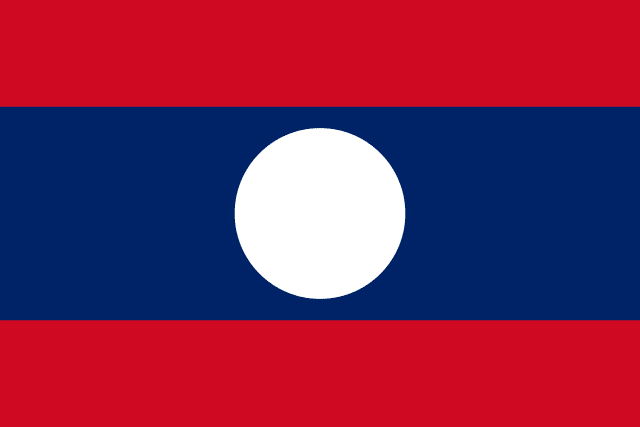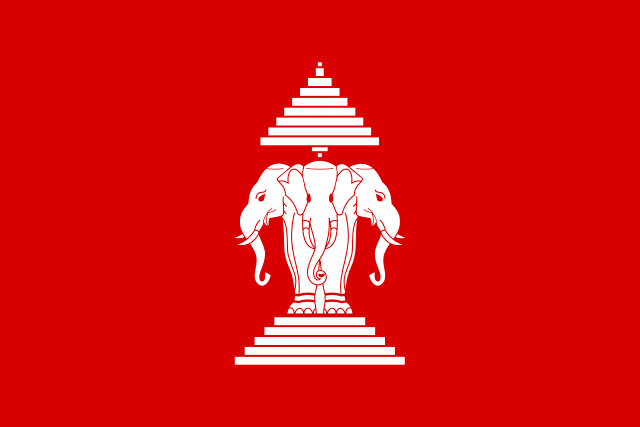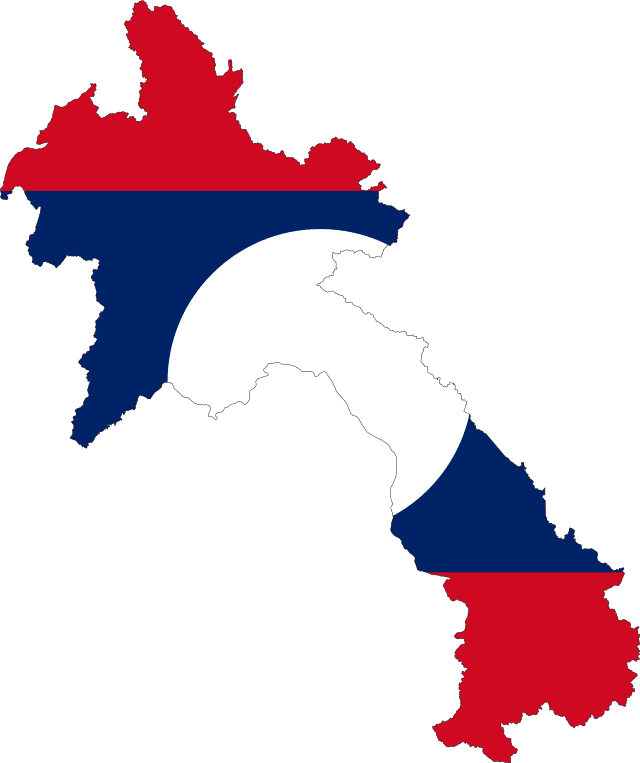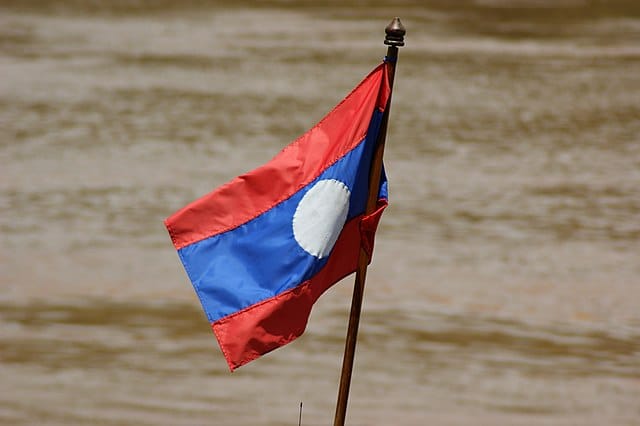When the communist Laos People’s Democratic Republic overthrew the King and assumed power on December 2, 1975, the present national flag of Laos was put into use. The flag features three horizontal stripes: two red stripes at the top and bottom, and a blue stripe in the middle with a white circle in the center that is twice as tall as the red stripes.
Since you came across this article, you must be wondering what the Laos flag represents and how it has evolved over time. So, let’s explore the symbolism, history, and interesting facts about the Laos flag.
Brief Overview of Laos
Perhaps not surprisingly, the Laos flag has been significantly influenced by neighboring countries. Considering this, before we discuss the characteristics of the Laos flag, it is important to learn more about the country’s geographic location.
The only landlocked nation in Southeast Asia is Laos. Laos is mostly made up of high mountains and wooded hills, which cover about three-quarters of the country. The Mekong River is essential as a means of transit for goods and people, as a source of energy at dams, as a source of water for farms, and as the habitat for fish, a key component of the Laotian diet. Between the mountains and the Mekong River, there are three plateaus: the Xiangkhiang, Khammouan, and Bolovens Plateaus.
Considering its location in French Indochina, the current time zone for Laos is GMT+7. Being part of the French colonial empire significantly affected the Laos flag.
Laos History
Specific historical events affected the Laos flag differently and caused modifications to it. Going through the historical patterns and development of the country will help us better understand each component of the flag.
The lower Mekong basin has been inhabited for at least 10,000 years. The Khmer people that presently inhabit Cambodia were linked to the initial immigrants. A Lao prince by the name of Fa Ngum returned to the nation in 1353 and proclaimed himself king of Lan Xang, also known as “the Kingdom of a Million Elephants.”
Most of Laos was seized by the Siamese in 1779. Siam is now known as Thailand. In 1893, French colonists seized power, drove the Siamese off of the western Mekong River, unified the nation, and gave it the name of Laos.
Until 1945, when the Japanese briefly took over, the French had been in charge of Laos. French enterprises were finally ejected once the country was granted complete independence by the French in 1953. Laos continued to be influenced by several nations. Immediately after gaining independence from France in 1953, the country descended into chaos.
The US considered Laos to be a crucial nation in the battle against communism and capitalism. Pathet Laos members rebelled against the United States support for the government, and Pathet Laos fought alongside communist North Vietnam against French-backed South Vietnam. During the Vietnam War, a large number of Laotians evacuated their nation when conflict erupted in neighboring Vietnam.

History Of Laos Flag
Laos’ present flag was created in 1945 by Maha Sila Viravong. Nevertheless, the Laos Issara administration only employed the flag for a single year. There have been several flag variations and changes utilized over the years.
While the parasol, or royal umbrella, had played a significant role in the king’s ceremonial regalia, the fabled first monarch of Laos had come riding a white elephant, an animal regarded in great veneration by peoples of Southeast Asia. Both the Kingdom of Laos and the Kingdom of Luang Prabang, which became a French protectorate in 1893, picked the white three-headed elephant and white parasol on a red background.
While it was a part of the French Empire, Laos was one of the few French colonies with its own flag. The three white elephants holding up a nine-layered umbrella on top of them are seen on the colonial flag of Laos, which has a solid red background. In the canton was also displayed the French tricolor flag. The crimson field served as a conventional metaphor for good fortune and joy in the culture of the country, while the elephants and umbrellas served as emblems of the country’s royalty.
A crimson flag with a white elephant with three heads served as Laos’ national flag from 1952 until 1975. This was intended to symbolize the regal monarchy. Flags that were in use before this one, dating back to the 18th century, had a similar style. The historic name of the nation, “Land of a Million Elephants,” was reflected by the three-headed elephant on the flag.
Armed opposition to the royal government was started in August 1950 by anti-colonialist groups known as the Pathet Lao. Their flag had a white disk on a red, blue, and red striped backdrop. That disk represented a bright future for the nation while also paying tribute to the Japanese, who had supported the Lao independence cause during World War II.
Blue was thought to represent the promise of future wealth, while red was said to represent the blood of those fighting for freedom and independence. Since the turn of the 20th century, when France was in charge, the royal kingdom of Luang Prabang has flown this flag, which was modeled after a banner that was used in Thailand at the time (a crimson flag with a single white elephant).
After the king was overthrown on December 2, 1975, thanks to Pathet Lao’s victory over American-backed forces, the Pathet Lao party flag was adopted in place of the traditional Laos flag. So, until the end of the royal administration in 1975, the three-headed elephant Laos flag was in use. Soon, when Laos became a socialist state, it was reinstated after ceasing to be used in 1946.

Symbolic Meaning Of Laos Flag
The Laos flag has a horizontal triband pattern with two distinct colors. A white disc is located in the middle of the flag. According to the flag’s creator, the white disc represents the nation of Laos’s united nature. The disc is also thought to depict a full moon rising over the Mekong River.
The Laotian flag’s colors have special meanings as well. Both the nation’s riches and its fight for freedom are symbolized by these hues. The blood that the Lao people lost throughout their fight for freedom and independence from the French is symbolized by the red stripes. The Mekong River, which represents the nation’s wealth, is symbolized by the color blue.
The bright future of the nation and the justice and unity of the Lao people under the leadership of the Lao People’s Revolutionary Party is symbolized by the white circle in the middle. A white circle in the center has a diameter that is 8/10 the height of the blue stripe and 8/10 the diameter of the disc circle.
Previous flags that portrayed elephants had different meanings. The five-level pedestal represented the legal framework of the nation. The three-headed elephant stood for the three ancient kingdoms that made up the nation: Vientiane, Luang Prabang, and Champasak.
According to Buddhist cosmology, the nine-folded umbrella perched atop the elephant is a regal emblem that comes from Mt. Meru.

Colors of Laos Flag
Three colors are used in the design of the Laotian national flag. Red is used for the triband’s outside bands, while blue is used for the center band. On top of the blue band is the white disc. The crimson stripes represent the blood of the Laotian people during their struggle for freedom from France. The blue color, which symbolizes the Mekong River and the country’s wealth, is used on the flag.

Culture of Laos
After exploring the history of the Laos flag, you may also wonder what’s special about the culture of this country. The largest is the Xiangkhiang, although more rich farmland is available close to Cambodia on the Bolovens Plateau, where coffee, tea, rice, strawberries, and pineapples are farmed. The lowlands are the most important to Laos. The Mekong River floods the area, supplying the land with nutrient-rich water that enables the growth of enough rice and other crops to feed the entire nation for a year.
The majority of the population is concentrated around the river, which flows from China through Laos and south Vietnam to the coast over a distance of more than 2,600 miles. The tallest mountain, Phu Bia, is 9,242 feet above sea level, and only 10% of the nation lies below 600 feet.
Surprisingly, the Laotian people have few material possessions beyond their food. Yet their Buddhist beliefs enable them to find contentment in a modest lifestyle. Most residents reside in small rural settlements close to rivers. To produce adequate food, the entire family works very hard. Many residents lack access to running water, so they must bring water from the river to their modest wooden homes in order to utilize it for cleaning, cooking, and drinking.
Final Thought
Did you know that Laos and Cambodia are the only communist nations that have flags without communist emblems? The contemporary Laos flag is unique in that it is a resurgence of a flag that was previously in use but was discontinued by a previous administration.
This served to distinguish it from the Laos flag that symbolized the country when it was a part of the French colonial empire. It was intended to create a flag that was separate from the royal banner of Laos.